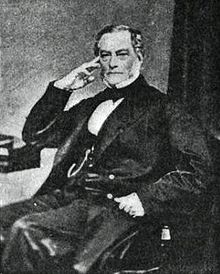Thomas Grubb – Wikipedia
From Wikipedia, the free encyclopedia
Irish engineer and telescope builder


Thomas Grubb (4 August 1800 – 16 September 1878) was an Irish optician and founder of the Grubb Telescope Company.
He was born near Portlaw, County Waterford, Ireland, the son of William Grubb Junior, a prosperous Quaker farmer and his second wife, Eleanor Fayle.
Thomas started out in 1830 in Dublin as a metal billiard-table manufacturer. He diversified into making telescopes and erected a public observatory near his factory at 1 Upper Charlemont Street, Portobello, Dublin. As makers of some of the largest and best-known telescopes of the Victorian era, the company was at the forefront of optical and mechanical engineering.[1] His innovations for large telescopes included clock-driven polar mounts, whiffletree mirror mounting cells and Cassegrain reflector optics.[2] Later, the manufacturing firm changed its name to Grubb-Parsons in 1925.[3]
Thomas Grubb’s reputation as a competent telescope maker began to spread as he offered his talents to the Irish astronomical community. Grubb first met the director of Armagh Observatory, Romney Robinson, sometime in the 1830s.[4] His first commission was for E.J. Cooper of Markree Observatory.[4] He was tasked to mount a 13.3 inch lens which was used to view the solar eclipse of 15 May 1836.[5]
Grubb helped build the famous telescope for William Parsons, 3rd Earl of Rosse, at Parsonstown (now known as Birr), County Offaly, Ireland. One of his earliest instruments – the telescope for Markree Observatory in County Sligo in the West of Ireland, supplied in 1834 – was, until 1839, the largest refracting telescope in the world.[6] It was used to sketch Halley’s comet in 1835 and to view the solar eclipse of 15 May 1836.[7]
Later he built telescopes for observatories worldwide, including Aldershot Observatory, Melbourne, Vienna, Madrid and Mecca and others.[5]
Thomas Grubb’s company also made various scientific devices for Trinity College in Dublin. In 1839, his company made about twenty sets of magnetometers.[4]
These magnetometers were requested by Professor Humphrey Lloyd who was very involved with Grubb’s work. He sought Grubb’s talents because so he could be close to the creation process and supervise his work.[4]
Starting from 1840, Grubb also worked as an engineer for the Bank of Ireland. He was responsible for designing machines used in the creation of banknotes.[4] These machines were used for engraving, printing and numbering the banknotes.[4]
Grubb made a contract with the government of Ireland in 1866 to construct a telescope that would be sent to the southern hemisphere for use to compare the sky from there. This project was a failure.[4] He was tasked of constructing a Cassegrain reflector that would include two 4-foot metal mirrors.[4] The problem with the project was Grubb’s choice of metal.[4] This caused defects in the form of the astronomers in Melbourne being unable to repolish the mirrors adequately.[4]
Late-Life[edit]
Thomas died in 1878 in Monkstown, County Dublin, Ireland.[4] He is buried at Mount Jerome Cemetery, Dublin, Ireland. He had married Sarah Palmer. Their youngest son was Sir Howard Grubb, who took over the optical business. Thomas Grubb’s cousin, John Grubb Richardson (1813 – 1891) was a major Irish industrialist who founded the model village of Bessbrook.[8]
References[edit]
- ^ Glass, I.S. (1997). Victorian Telescope Makers: The Lives and Letters of Thomas and Howard Grubb. Institute of Physics Publishing (Taylor and Francis). ISBN 0-7503-0454-5.
- ^ A Short History of Armagh Observatory
- ^ McCartney, Mark; Whitaker, Andrew (2003). Physicists of Ireland Passion and Precision. London: Institute of Physics. p. 52. ISBN 978-0750308663.
- ^ a b c d e f g h i j k Burnett, John. “Grubb, Thomas (1800–1878), engineer and telescope builder.” Oxford Dictionary of National Biography. 23 Sep. 2004; Accessed 1 Mar. 2023.
- ^ a b Todd, David Peck; Lynn, William Thynne (1899). Stars and Telescopes. Boston: Little, Brown, and Company.
David Todd stars telescopes.
- ^ A Recently Discovered Photograph of Edward Joshua Cooper of Markree (1797-1863)
- ^ History of the Cauchoix objective
- ^ Grubb, Geoffrey Watkins (1972). The Grubbs of Tipperary. Mercer Press.
External links[edit]
Recent Comments